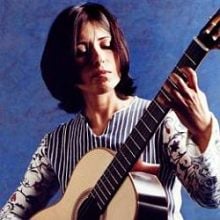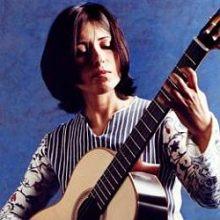The Spanish guitarist Margarita Escarpa offered a recital notable for finely wrought emotion, beautiful sound, and flawless technique on Saturday at the Green Room of San Francisco’s War Memorical Veterans Building. The Omni Foundation for the Performing Arts and the Government of Spain presented the recital as homage to the Spanish guitarist and composer Francisco Tárrega, commemorating the 100th anniversary of his death.

By the late 19th century, the guitar had gone out of fashion in a musical world dominated by the sounds of the concert grand piano and of large symphony orchestras. Tárrega, by reinventing the style of earlier composers’ romantic piano miniatures in terms of the guitar, gave a new voice to the instrument, which led to its 20th-century revival.
Escarpa began her program with a group of seven of these compositions. Endecha, a brief funeral song, alternates passages of single notes with chordal textures, while Oremus is a prayer chanted in double-stops; both offer evanescent tastes of emotion, lasting less than a minute each. The Prelude in A minor requires the guitarist to maintain a dialogue between two melodic lines in contrasting registers, while playing a chordal accompaniment and executing challenging position changes. The Gavota (Maria) is a portrait of personal whimsy; the Mazurka in G major is tender and heartfelt (while asking the performer tastefully to execute glissandos, ornaments, and slurs). In Adelita there’s a melancholy, minor-key sighing motive, contrasted with music in an optimistic and lilting major key. And Capricho Arabe, the final piece in this set, evokes the history of Arabs in Spain with intricate melodic arabesques and modal harmony.
Escarpa played all of this music with wonderful sensitivity to late-Romantic performance style: Tempos and rhythm were subtly altered, portamentos or slides connected notes, prominent moments were colored with various degrees of vibrato — all in a manner that heightened the effect of intense, personal emotion.
Carrying On a Tradition of Transcription
Tárrega was a friend of the great Spanish composer Isaac Albéniz, and the first to arrange his music for the guitar. Escarpa followed Tárrega’s example by offering her own arrangements of three of Albéniz’s compositions.
Granada brings to mind a nocturnal serenade performed under the window of a loved one, accompanied by the strumming of a guitar. Córdoba evokes Spain with a melody reminiscent of Gregorian chant over chords like tolling church bells, giving way later to an impassioned serenade capped by flamenco-like strumming. Cataluña is a Spanish dance related to the French courante; the traditional running gestures, limned in amazingly virtuosic counterpoint, were played by Escarpa with apparent ease and great panache.
Tárrega was also the first guitarist to arrange the music of Bach, and Escarpa again followed suit with her own arrangement of the four-movement Sonata, BWV 1001 (originally for solo violin). The opening Adagio was played with a rhythmic flexibility that highlighted the improvisatory inspiration of the movement. The subject and the complex texture of the Fuga were clearly articulated, and the continually evolving musical argument was enhanced by a sensitive use of dynamics. A gentle and introspective interpretation of the Siciliano provided a peaceful interlude before a bravura performance of the rhythmically complex Presto.
Next Escarpa gave the San Francisco premiere of Appassionata by Ronaldo Miranda, winner of the Carlos Gomez prize for Composer of the Year in Brazil. An ambitious single-movement piece written in 1984, it is modeled on the late-Romantic pianistic tradition. Escarpa highlighted its rich harmonies with a gorgeous tone and bold gestures.
The program proper came to a conclusion with more Tárrega: his Fantasia sobre “La Traviata” de Verdi (an operatic paraphrase in the manner of Liszt). Escarpa’s encore was an arrangement of Tchaikovsky’s “June (Barcarola),” from the set of piano miniatures called The Seasons.

